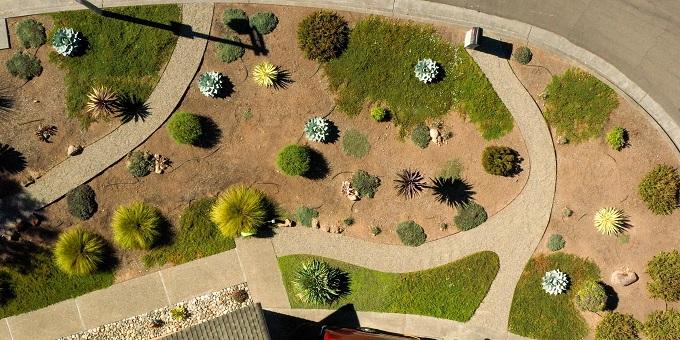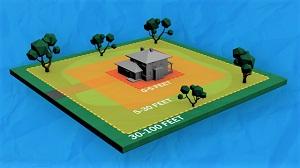
Wildfire Preparedness in the Home Landscape

As we adapt to the impacts of climate change in our environment, we need to acknowledge that wildfire and increasing periods of drought are a part of our landscape. It can seem overwhelming to try to manage what seem to be competing interests. Our goal is to design and maintain our homes and adjacent property in ways that reduce their vulnerability to wildfire but also provide critically important ecosystem services. Some longstanding design practices will need to shift as we adapt. We envision a resilient future where each of us is adapting to the needs of our changing climate and preparing for future fires while ensuring optimal support for biodiversity and our environment.
Resources:
- UCANR Fire Preparedness web page
- Resilient Landscapes Coalition Sustainable Defensible Space
- UC Master Gardener Program of Sonoma County article on defensible space
- Red Flag Warning Day Preparedness
- Zone Zero Defensible Space Video (Learn the basics for creating the first defensible space zone immediately around your home perimeter from 0-5’, the ember resistant zone.)
- Sustainable Defensible Space video (Creating defensible space is one of the most important actions we can take to improve the odds that a home will survive a wildfire. This video takes you through the basics of the 0-100’ defensible space around your home and structures.)
- Full UC Master Gardener Program of Sonoma County You Tube Playlist of Wildfire Videos
Where to Start: Home Hardening
Start with home hardening. After you harden your home, start working on creating defensible space from the house out. Think of our recommendations as a risk assessment for your home and landscape. And make sure you are complying with local fire regulations.
Resources:
- Resilient Landscape Design (Pacific Horticulture website)
- UCCE Fire in California, Preparing Your Home
- UCANR Publication 8393: Home Survival in Wildfire-Prone Areas: Building Materials and Design Considerations
Preparing Your Home Landscaping
While every landscape is unique, each of us needs to not only do what is required by law but also consider our personal and family risk in preparing for the next wildfire. Per University of California Agriculture & Natural Resources Division advisors working on this topic, “research has demonstrated that by careful attention to the selection, location, and maintenance of vegetation and other combustibles on the property (i.e., the defensible space on the property), implementing retrofits to ‘harden’ the home, and implementing an ongoing maintenance program, it is possible to improve the odds that a home will survive a wildfire.” (Valachovic, Quarles, and Swain 2021)
Resources:
Plant Considerations
Often the first questions we hear are “What should I plant?” or “Can you provide me with a firesafe plant list?” The reality is that all plants will burn. How a plant is maintained, where it is placed, and the overall design of the garden are likely more relevant to whether a plant will burn, rather than its species characteristics. It’s more important to consider plant placement, use of hardscape to break up planted areas, and ongoing plant maintenance to reduce risk of fire moving through your landscape.
It’s equally important to provide habitat in our gardens to support wildlife. We recommend selecting native plants that will thrive in your environment, and provide food and shelter for birds, pollinators and other wildlife. And make sure you are keeping plants healthy and happy with appropriate irrigation. Many locally native plants can require far less water. Well maintained plants are more resistant to fire and pests & diseases.
In all the zones, be aware of plants growing below trees, and remove any ladder fuels. The rule of thumb is that the space from the top of any plant to the lower branches of a tree should be 3 times the height of the lower plant because if that lower plant ignites, flames can reach up and ignite the branches above, creating a more dangerous fire.

Ember Resistant Zone: Your first defensible space zone is the one immediately around your home perimeter from 0-5’. The goal here is to prevent embers from igniting your home. Walk around your home and think where embers could land and start a fire.
What to look for:
- Do you have any plants or combustible materials that can be removed?
- Do you have a deck attached to your home?
- Remove any flammable materials or wood mulch from beneath and within several feet of your deck and ideally screen the area beneath your deck.
- Fences: Embers can easily set a wood fence on fire. Make sure you replace any wooden fences or gates attached to your home with metal or other noncombustible materials.
- Use inorganic materials such as gravel or stepping stones in the 0-5’ perimeter around your home, decks, and other flammable outbuildings
- Here are places that are especially prone to spreading fire to your home. At a minimum any plant materials in these areas should be removed
- Tree limbs that overhang your home can result in a greater accumulation of debris on your roof and near the home. Throughout fire season, make sure you are regularly cleaning debris from your roof and gutters.
Home Defense Zone: Think of the next zone, 5-30’, as the place where you want to slow down the fire and give firefighters a place to stage their defense. Focus on creating more space between garden beds, shrubs and trees so that if a wildfire does come into this zone the vegetation will not be able to burn to the house or into the crowns of trees. To achieve this, plant in “islands” separated by hardscape. Optimally select lower growing plants up to 3’ in height such as groundcovers, mown native grass, herbaceous perennials and succulents.
Individual trees and larger shrubs are OK in this zone as long as they are well separated, well maintained and don't create ladder fuels. This is a great zone for hardscape elements such as a water feature, brick patio, paving stones, dry creek bed, or boulders.
Reduced Fuel Zone: In the 30-100' zone around your home, the goal is to reduce the speed of approaching wildfire. In this zone, plants can be taller than in the 5-30' zone, still placed in islands separated by pathways of mown and well hydrated native grasses, or composted mulch or gravel to impede the spread of fire. You don’t have to create a moonscape by removing all plant materials -- just focus on breaking up areas of planting! In areas that are densely vegetated, increase the spacing between trees or groups of trees, and limb up lower branches of trees and shrubs.
Existing Landscapes
If you’re looking to make an existing landscape more firewise, you can apply all these same concepts. Try to see your landscape through a different lens, and look at whether there are receptive fuel beds which would ignite if embers landed there. How can you reduce the fuel receptivity through maintenance or plant removal? Be honest about your capacity to do the required maintenance of plant materials if you choose to keep them.
- Remove plants & wood mulch in the 0-5’ zone around your home.
- Limb up all trees 6’ from the ground, and remove any shrubs beneath trees, or ? their height, whichever is less.
- Break up planted areas into islands of plantings separated by hardscape. If your property is on a steeper slope, then you should increase the thinning between plants.
- Look at where you can create new noncombustible areas—such as permeable landscaping using gravel—between plantings or defensible space zones to interrupt the flow of fire.
- Incorporate low-water-use native plants into your landscape.
- Maintenance is just as important as the design of your garden. Throughout the year make sure you are removing dead plants and dead branches from trees and shrubs. It’s also important to keep dead leaves and branches from accumulating in the center of a plant which will make it more flammable.
Additional maintenance tips include:
- Prune and thin vegetation in fall and early winter to avoid harm to bird breeding (birds breed generally from mid-February to the end of July).
- Don’t cut grass to bare dirt; it’s important to keep viable vegetation in place for erosion control.
- Don’t let leaf litter accumulate more than 1” during fire season within 30’ of the home, and remove it completely within 5’ at the beginning of and during fire season. Allowing leaf litter to remain during the rainy season is acceptable, and it is critical to healthy trees and soil microorganisms.
More detailed information on Yard Maintenance.
Mulch
A layer of mulch helps with weed suppression and water conservation, but wood mulches are combustible so they shouldn’t be used in a widespread or continuous manner. Most importantly, wood mulch should not be used in the 0–5’ zone around your home. Separate mulched planted areas with noncombustible materials such as concrete, gravel, or a mown native grass strip. Composted materials demonstrated the least hazardous fire behavior in mulch flammability research studies. Choose well-composted, larger-size arbor mulch and avoid shredded bark mulch, which can tend to smolder.
Additional Resources
- Wildfire Research Near Building Combustible Zone
- The Effects of Smoke and Ash on Plants
- Produce Safety After Wildfire
- The Combustibility of Landscape Mulches
- 10 Ways To Protect Your Home From Wildfires
- What to do if a Wildfire is Approaching
- Cal Fire Ready for Wildfire
- Fire Safe Sonoma
- County of Sonoma Department of Emergency Management So Co Alert
- UCCE Sonoma map resources
December 2021







